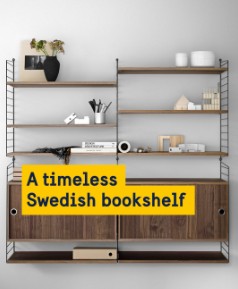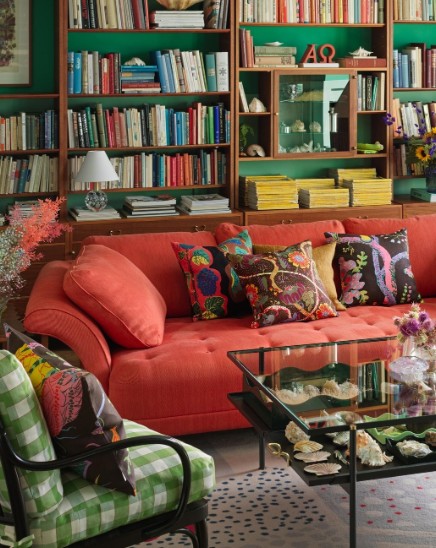Swedish design
Swedish design is about making beautiful things for everyday life – in a green way. Here are some old and new pioneers.
There are certain characteristics that set Swedish design apart. One is a long tradition of environmentally friendly production. Another is transparency, for products as well as production – it’s often easy to see how a product is made and of what material, and producers are open about the production process.
The classic Swedish emphasis on functionality and reduced form has undergone a change, and today sophisticated colour schemes, a broad range of sustainable materials and conceptual ideas form a new diversity.
Collaborations between design producers and small-scale crafts industries is also an important aspect of contemporary Swedish design.
10 pioneers in the Swedish design field:
1. Artur Lindqvist (1897–1983)
Furniture designer. His garden chair A2 from 1930 gained recognition for its unique spring steel construction, which lends it a peaceful swing.
2. Astrid Sampe (1909–2002)
Textile designer, introduced the printed towel in Sweden. Her pattern Persons kryddskåp from 1955 is a classic in the kitchen.
3. Bruno Mathsson (1907–1988)
Furniture designer and architect. His chair Pernilla from 1944 is an international icon.
4. Gillis Lundgren (1929–2016)
Furniture designer at IKEA, and the man behind the flat-pack and ready-to-assemble furniture. The Billy bookshelf from 1979 is a worldwide bestseller.
5. Gunilla Lagerhem Ullberg (1955–2015)
Textile designer at Kasthall. In 1998 Moss, her contemporary interpretation of the traditional Swedish ‘rya’, brought the long-piled rug back into fashion.
6. Josef Frank (1885–1967)
Designer at Svenskt Tenn from 1934. His colourful patterns often blend dream and reality, like Teheran, created in the 1940s.
7. Märta Måås-Fjetterström (1873–1941)
Textile artist, made the Swedish ‘röllakan’ flatweave technique world famous. Her rug Bruna Heden, with its graphic pattern, was created in 1931.
8. Nisse Strinning (1917–2006) and Kajsa Strinning (1922–2017)
Industrial designers. Their shelving system Stringhyllan has been popular ever since its launch in 1949.
9. Sixten Sason (1916–1967)
Industrial and product designer for Saab automobiles, Electrolux vacuum cleaners and many more. In 1943 he developed the Hasselblad camera 1600F.
10. Stig Lindberg (1916–1982)
Designer and illustrator. Berså from 1961 is one of his most beloved patterns.
5 Swedish design awards
- The Bruno Mathsson Award (link in Swedish)
- Design S
- Grand Award of Design
- The Torsten and Wanja Söderberg Prize (link in Swedish)
- Ung Svensk Form – Young Swedish Design
10 contemporary Swedish designers
1. Anki Gneib
Anki Gneib's work is experimental and playful. She rediscovers materials, styles and craftsmanship from around the world and likes to investigate different cultures. Gneib combines a strong personal style with a pragmatic, useable approach. She has done work for Swedish brand Nola, among others.
2. BAUX
BAUX is Johan Ronnestam together with Form Us With Love. They are experts on acoustics combined with pioneering sustainable materials. One example is acoustic felt made from upcycled post-production textiles, an idea in line with Baux’s tradition of finding inspiration in nature.
3. Eva Davidsson
Eva Davidsson (link in Swedish) works mostly with textile crafts and design, often with inspiration from the Shibori dyeing technique. Davidsson has done everything from knitted garments to interior design objects – for both private and public environments.
4. Färg & Blanche
Furniture designers and curators Fredrik Färg and Emma Marga Blanche together make up Färg & Blanche. The experimental duo is based in Stockholm, but they work worldwide. Their collaborations include a number of established furniture brands.
5. Gärsnäs
Family-owned Gärsnäs have been making long-term choices for a long time. Craftmanship and sustainable materials have been at the forefront of their production since the business was started in 1893.
6. Lies-Marie Hoffmann
Lies-Marie Hoffmann's makes wooden art and design objects for public spaces. She has a strong sustainable ambition and Hoffmann aims to improve people's relationship to nature through her craftsmanship.
7. Matti and Simon Klenell
Brothers Matti and Simon Klenell have co-created a design for classic Swedish glass brand Kosta Boda, exploring the possibilities of glass as a craft. Independently, Matti Klenell has worked in many different materials, but often return to glass. And Simon Klenell works almost exclusively in glass.
8. Mimmi Blomqvist
Mimmi Blomqvist strives to merge the concepts of utility items and sculpture in her designs. She has done work for classic Swedish interior design company Svenskt Tenn, among others. Blomqvist makes every item by hand in her studio in Stockholm.
9. Monica Förster
Monica Förster is one of Sweden’s most rewarded design studios working on an international level for companies such as Alessi, Cappellini, De Padova, Georg Jensen, Offecct, Poltrona Frau, Rörstrand, Skultuna, Swedese and Volvo. In 2023 Förster was awarded one of Europe's most prestigious design awards, AW Designer of the Year.
10. Samuel Wilkinson
International award winner Samuel Wilkinson has been nominated for his furniture design for Swedish brand Gemla. He combines a deep understanding of materials and manufacturing with a high level of detail and craftsmanship.
Sustainable Swedish design
Bolon makes innovative flooring solutions for public spaces. It is a third-generation family business run by sisters Annica and Marie Eklund. Under their leadership, Bolon has been transformed from a traditional weaving mill into an international design brand. With a strong commitment to sustainability, Bolon designs and manufactures all its products at a facility in Ulricehamn in southern Sweden. The company is recognised worldwide for its award-winning flooring and collaborations with some of the world’s most acclaimed innovators and creatives.
Sustainordic is a network initiated by the ArkDes museum in Stockholm and Form/Design Center Malmö. The project promotes and analyses sustainable consumption and production in the Nordic countries.
Swedish design organisations
Svensk Form
Founded in 1845, the Swedish Society of Crafts and Design – Svensk Form – is the oldest design society in the world. It is a non-profit association with a government mandate to promote Swedish design, both nationally and internationally.
SVID
The Swedish Industrial Design Foundation (SVID) aims to encourage the private and public sectors to integrate design methodology into their activities as a competitive tool. Its target groups include industry and commerce, local government, designers, universities and colleges.
Swedish Arts Council
The Swedish Arts Council is a government agency whose principal task is to implement national cultural policy and promote development in the cultural sphere.
ArkDes museum
Svensk Form collaborates with ArkDes, the Swedish architecture and design centre in Stockholm, to promote the role of architecture and design in society.
Design colleges
At the beginning of the 2000s, a shift could be noticed among Sweden’s design and art colleges and their recent graduates. Focus changed from a deep interest in technology, materials and function towards a new desire to tell a story with the things they made, to use these objects to comment on our times and their own activities. As part of this process, commercial culture and its various manifestations came to be placed on a par with more traditional aesthetics.
Some of Sweden’s design and art colleges are, in alphabetical order:
- Beckmans College of Design in Stockholm was founded in 1939 by Anders Beckman, a pioneer in the young Swedish advertising industry. Beckmans offers bachelor's programmes in product design, fashion and visual Communication.
- HDK-Valand – Academy of Art and Design is part of the University of Gothenburg. The craft courses at the school include jewellery, textiles and ceramics.
- Konstfack – University College of Arts, Crafts and Design, founded in 1844, is one of the oldest art and design colleges in Sweden. Located just south of central Stockholm, it offers courses at bachelor’s and master’s levels. It has around 900 students and 200 employees.
- Lund University School of Industrial Design in the south of Sweden offers teaching at bachelor’s and master’s levels, and also has a PhD programme.
- The Swedish School of Textiles in Borås, east of Gothenburg, offers expertise in all textile fields from crafts and design to technology, production, finance and marketing.
- Umeå Institute of Design in northern Sweden provides four academic programmes focusing exclusively on industrial design and related specialisations. The college was founded in 1989.
In addition, there are now several schools that focus specifically on graphic design and communication, such as Berghs, Forsbergs and Hyper Island. Their programmes blend communication studies with courses in graphic design and creativity.


